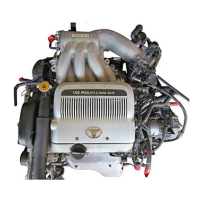RADIATOR
The radiator performs function of cooling the engine coolant which has passed through the water jacket
and become hot, and it is, mounted in the front of the vehicle. The radiator consists of an upper tank and
lower tank, and a core which connects the two tanks. The upper tank contains the inlet for engine coolant
from the water jacket and the filler inlet. It also has a hose attached through which excess engine coolant
or steam can flow. The lower tank has an outlet and drain cock for the engine coolant. The core contains
many tubes through which engine coolant flows from the upper tank to the lower tank as well as to cooling
fins which radiate heat away from the engine coolant in the tubes. The air sucked through the radiator by
the cooling fan, as well as the wind generated by the vehicle’s travel, passes through the radiator, cooling
the engine coolant. Models with automatic transmission include an automatic transmission fluid cooler built
into the lower tank of the radiator. A cooling fan is mounted behind radiator to assist the flow of air through
the radiator. When the engine coolant temperature is low, the fan operates slowly to help the warm up, and
when the engine coolant temperature becomes high, the fan speed is increased to provide the air flow re-
quired for cooling.
RADIATOR CAP
The radiator caps are pressure type caps which seal the radiator and, resulting in pressurization of the ra-
diator as the engine coolant expands. The pressurization prevents the engine coolant from boiling even
when the engine coolant temperature exceeds 100°C (212°F). A relief valve (pressurization valve) and a
vacuum valve (negative pressure valve) are built into the radiator cap. The relief valve opens and lets steam
escape through the overflow pipe when the pressure generated inside the cooling system exceeds the limit
(engine coolant temperature: 110–120°C (230–248°F), pressure; 69–113 kPa (0.7–1.15 kgf/cm
2
,
10.0–16.4 psi). The vacuum valve opens to alleviate the vacuum which develops in the engine coolant sys-
tem after the engine is stopped and the engine coolant temperature drops. The valve’s opening, allows
the engine coolant in the reservoir tank to return to the cooling system.
RESERVOIR TANK
The reservoir tank is used to catch engine coolant which overflows from the cooling system as a result of
volumetric expansion when the engine coolant is heated. The engine coolant in the reservoir tank returns
to the radiator when the engine coolant temperature drops, thus keeping the radiator full at all times and
avoiding needless engine coolant loss.
Check the reservoir tank level to learn if the engine coolant needs to be replenished.
WATER PUMP
The water pump is used for forced circulation of engine coolant through the cooling system. It is mounted
on the front of the cylinder block and driven by a timing belt.
THERMOSTAT
The thermostat has a wax type bypass valve and is mounted in the water inlet housing. The thermostat
includes a type of automatic valve operated by fluctuations in the engine coolant temperature. This valve
closes when the engine coolant temperature drops, preventing the circulation of engine coolant through
the engine and thus permitting the engine to warm up rapidly. The valve opens when the engine coolant
temperature has risen, allowing the circulation of engine coolant. Wax inside the thermostat expands when
heated and contracts when cooled. Heating the wax thus generates pressure which overpowers the force
of the spring which keeps the valve closed, thus opening the valve. When the wax cools, its contraction
causes the force of the spring to take effect once more, closing the valve. The thermostat in this engine
operates at a temperature of 82°C (180°F).
ELECTRONICALLY CONTROLLED HYDRAULIC COOLING FAN (See page EG–263)
–ENGINE TROUBLESHOOTING COOLING SYSTEM
EG–241

